Missouri is home to a fascinating array of sparrows, with a total of 22 distinct species inhabiting its diverse landscapes.
From the lively melodies of the Chipping Sparrow to the elusive nature of the LeConte’s Sparrow, each species contributes to the vibrant avian tapestry of the state.
In this exploration, we delve into the lives of these 22 sparrows, uncovering their unique characteristics, habitats, and roles in Missouri’s ecosystems.
Whether you’re an avid birdwatcher or simply intrigued by the rich biodiversity of Missouri, this guide provides a comprehensive overview of the various sparrow species that call the Show-Me State home.
Join us on this avian journey as we unravel the stories of these 22 sparrows, offering a glimpse into their captivating world within the heart of the Midwest. Stay sharp.
22 Sparrows in Missouri
Check out Missouri’s diverse world of sparrows, each with its unique features and habits.
From the Chipping Sparrow’s melodious songs to the Clay-colored Sparrow’s subtle beauty, these avian residents contribute to the rich tapestry of Missouri’s birdlife.
Discover their sizes, habitats, and distinctive characteristics in this informative guide.
1. White-crowned Sparrow
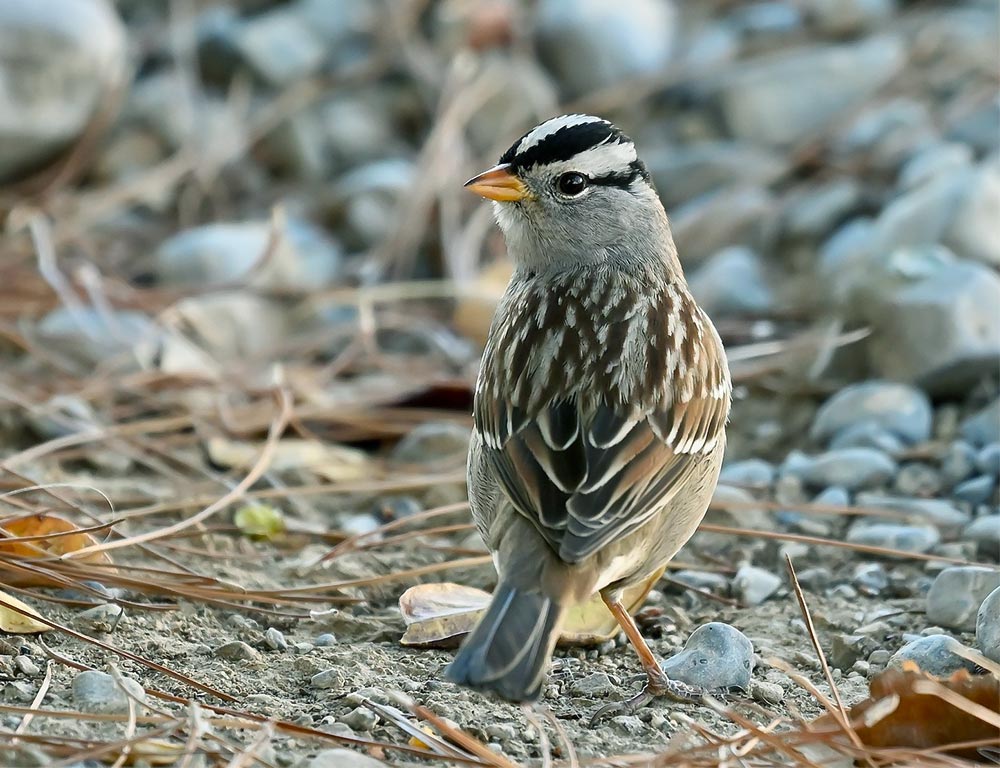
- Scientific Name: Zonotrichia leucophrys
- Size: 6.3-7.9 inches
- Weight: 0.8-1.5 ounces
- Population: Common and widespread
- Life Span: Up to 9 years
- Food: Seeds, insects, and small invertebrates
- Wingspan: 9.8-11.8 inches
The White-crowned Sparrow is a distinctive bird with bold black and white stripes on its head. In Missouri, these sparrows are often found in open habitats like shrubby areas, gardens, and grasslands.
They are known for their sweet, clear, whistle-like songs. Their diet consists mainly of seeds, insects, and small invertebrates.
These sparrows are adaptable and can be seen foraging on the ground or in low vegetation.
2. Golden-crowned Sparrow
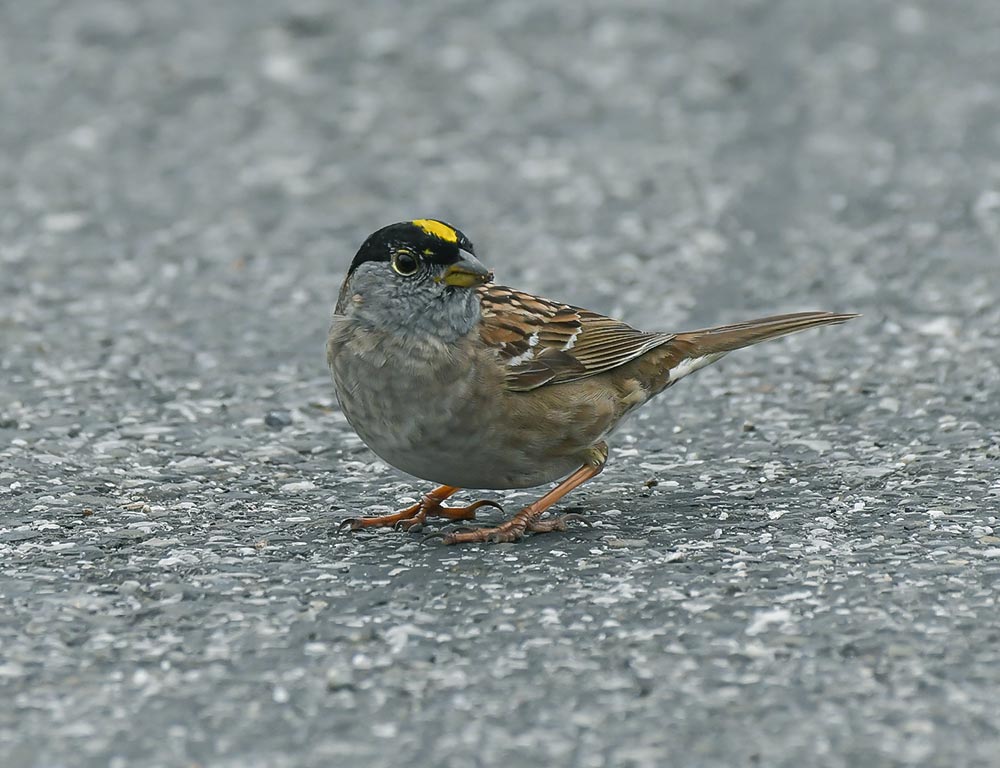
- Scientific Name: Zonotrichia atricapilla
- Size: 6.3-7.5 inches
- Weight: 1-1.3 ounces
- Population: Common in winter
- Life Span: Up to 9 years
- Food: Seeds, insects, berries
- Wingspan: 9.8-11.8 inches
Golden-crowned Sparrows are winter visitors to Missouri. They have a striking yellow crown on their head, which contrasts with the dark stripes.
These sparrows are often found in weedy fields, open woods, and along water edges. Their diet includes seeds, insects, and berries.
During the winter, they may form flocks with other sparrow species, making their presence noticeable in the region.
3. Harris’s Sparrow
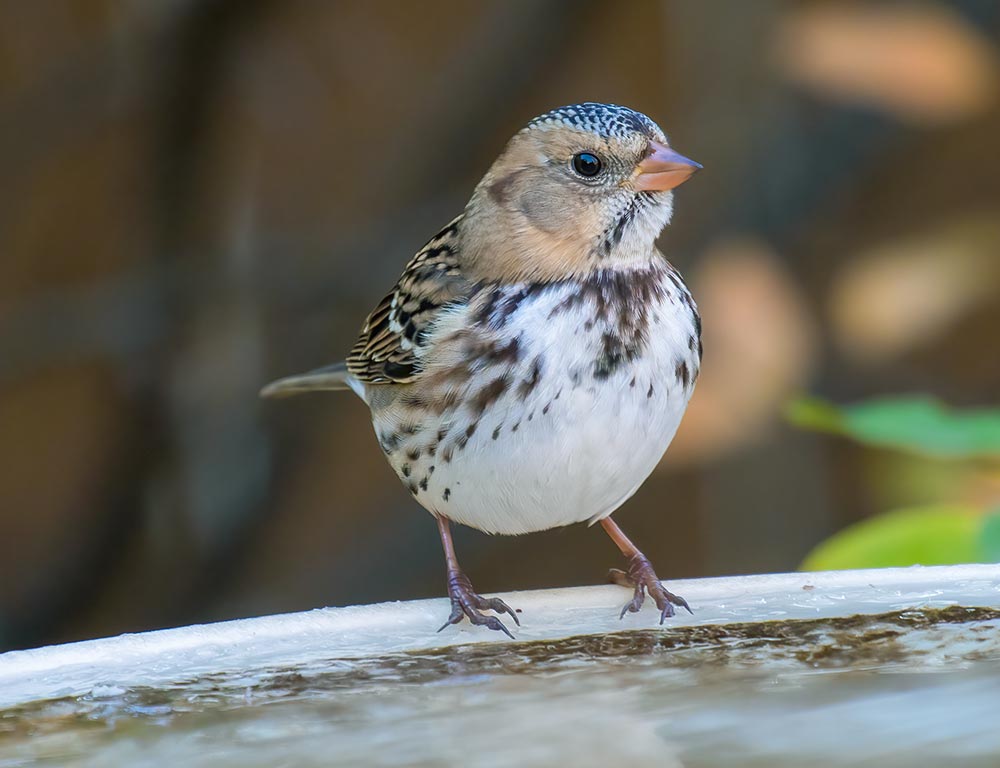
- Scientific Name: Zonotrichia querula
- Size: 7.5-8.3 inches
- Weight: 1.1-1.6 ounces
- Population: Local and migratory
- Life Span: Up to 9 years
- Food: Seeds, insects, berries
- Wingspan: 10.6-11.8 inches
Harris’s Sparrow is a large, robust sparrow with distinctive black markings on its face and throat.
They breed in northern Canada and migrate to Missouri during the winter. These sparrows are common in brushy areas, grasslands, and open woodlands.
Their diet consists of seeds, insects, and berries. They are known for their clear, melodious songs during the breeding season.
4. White-throated Sparrow
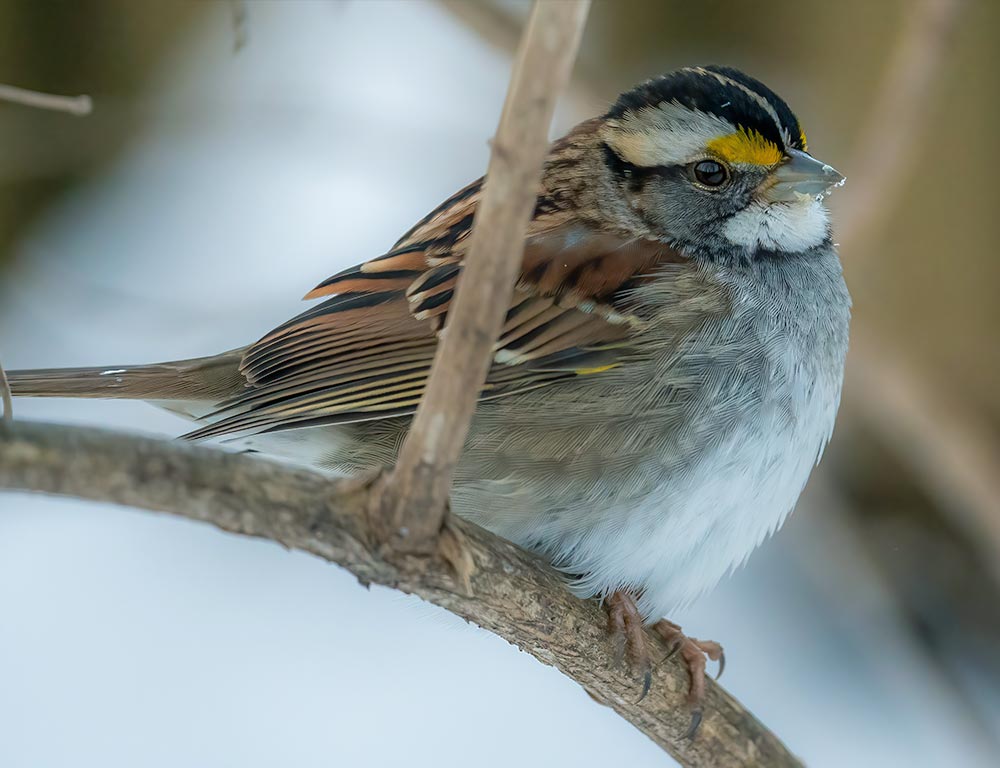
- Scientific Name: Zonotrichia albicollis
- Size: 6.3-7.1 inches
- Weight: 0.8-1.2 ounces
- Population: Common and widespread
- Life Span: Up to 9 years
- Food: Seeds, insects, fruits
- Wingspan: 8.7-9.8 inches
The White-throated Sparrow has a distinct white throat patch and yellow markings above its eyes.
It is a common year-round resident in Missouri, often found in various habitats such as woodlands, gardens, and suburban areas. These sparrows feed on seeds, insects, and fruits.
They are known for their clear whistle-like songs, and their white-striped crown makes them easily identifiable. White-throated Sparrows are adaptable and can be seen foraging on the ground or in low vegetation.
5. Vesper Sparrow
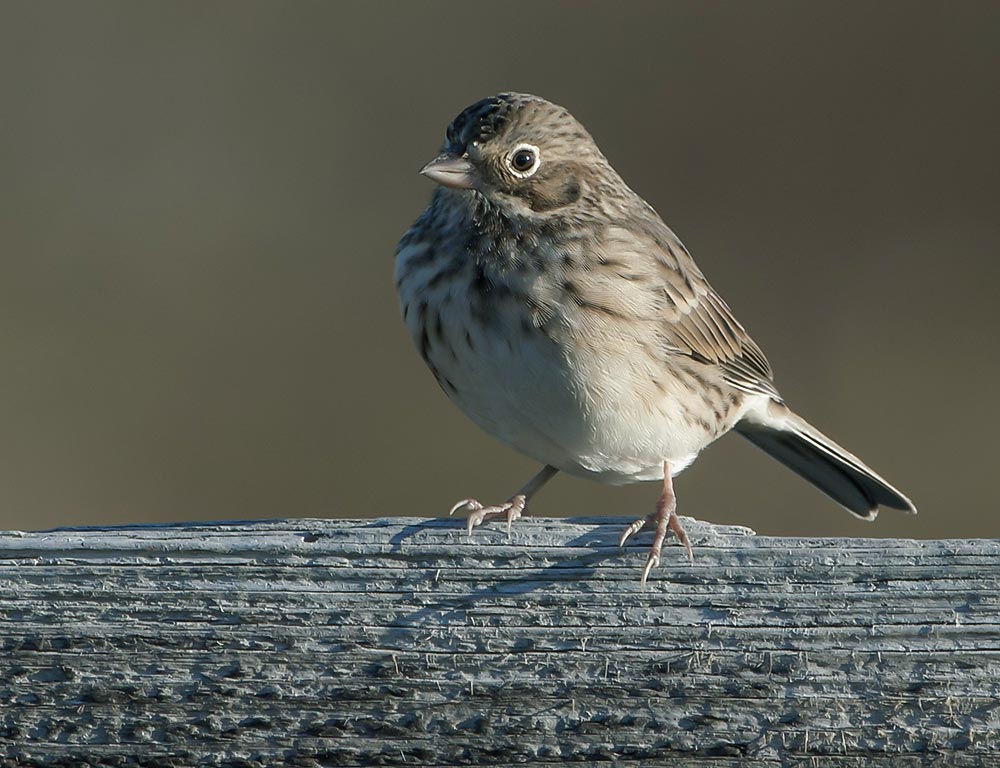
- Scientific Name: Pooecetes gramineus
- Size: 5.5-7.1 inches
- Weight: 0.5-1.2 ounces
- Population: Common in grasslands
- Life Span: Up to 6 years
- Food: Seeds, insects
- Wingspan: 9.8-11.0 inches
The Vesper Sparrow is commonly found in open grasslands and meadows. It has a streaked brownish back, a white eye ring, and a white outer tail.
Vesper Sparrows are known for their distinctive songs during the breeding season, often delivered from a prominent perch.
Their diet includes seeds and insects, making them important for pest control in agricultural areas.
6. LeConte’s Sparrow
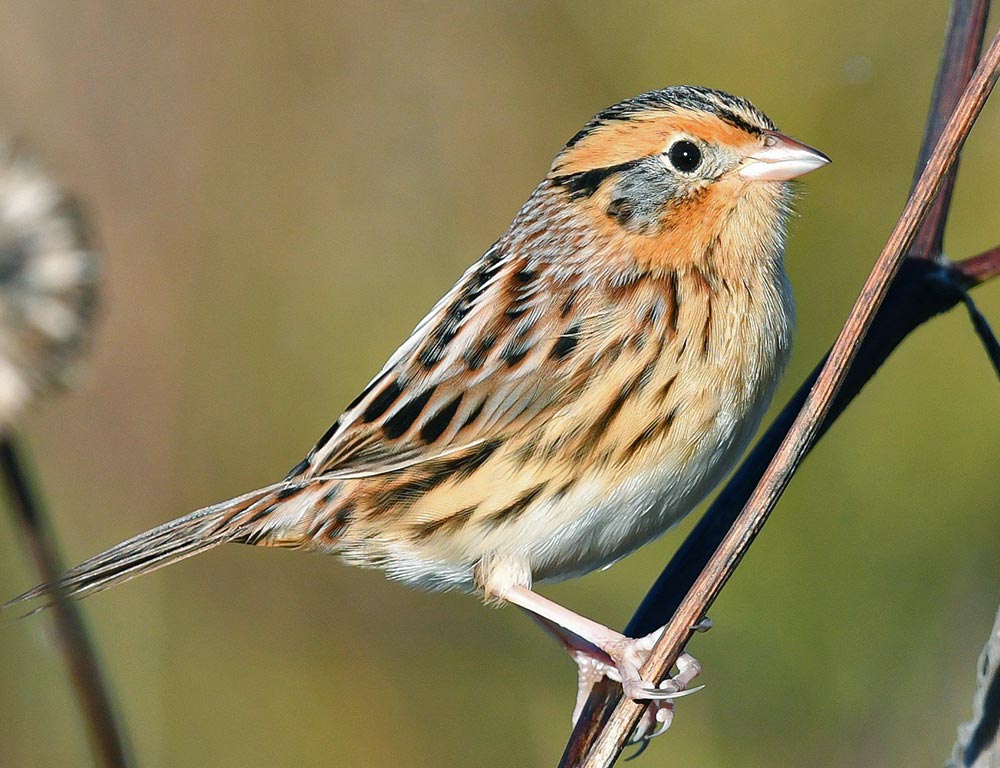
- Scientific Name: Ammospiza leconteii
- Size: 4.7-5.9 inches
- Weight: 0.3-0.5 ounces
- Population: Localized and migratory
- Life Span: Up to 6 years
- Food: Seeds, insects
- Wingspan: 6.7-8.3 inches
LeConte’s Sparrow is a secretive bird that breeds in wet grasslands and meadows. They have a distinctive buffy face and heavily streaked back.
During migration, they may pass through Missouri. This species is often associated with dense vegetation near water, where they forage for seeds and insects.
Their cryptic behaviour and habitat preferences make them a challenging but rewarding find for birdwatchers.
7. Nelson’s Sparrow
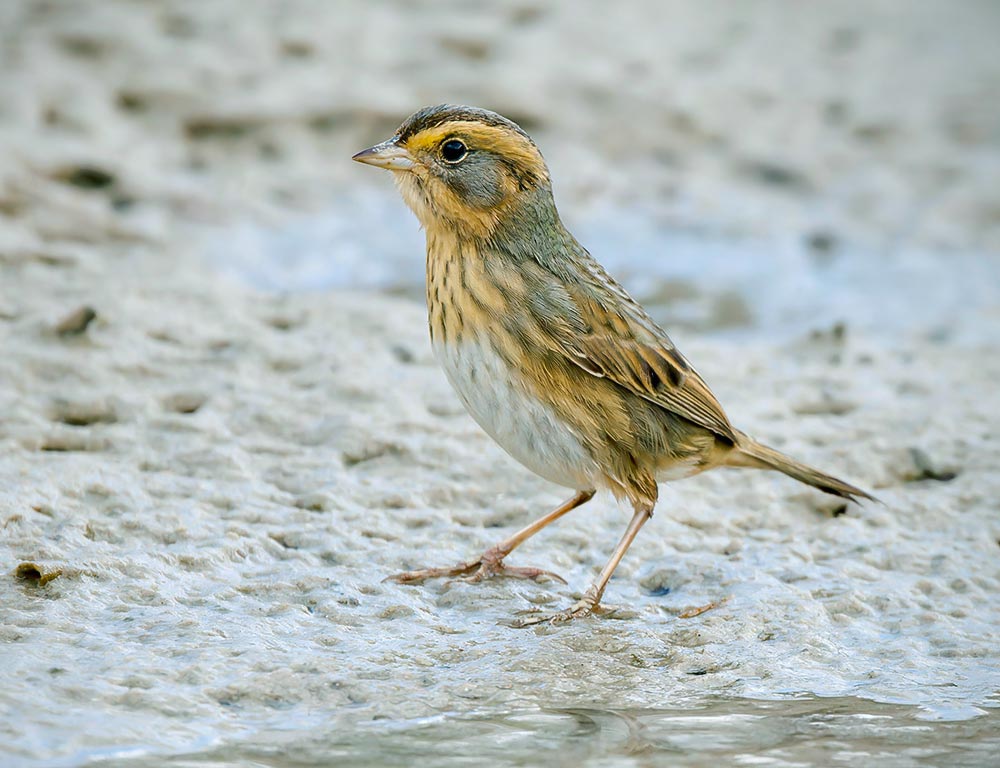
- Scientific Name: Ammospiza nelsoni
- Size: 4.7-5.9 inches
- Weight: 0.4-0.7 ounces
- Population: Localized and migratory
- Life Span: Up to 6 years
- Food: Seeds, insects
- Wingspan: 6.7-8.3 inches
Nelson’s Sparrow is another secretive sparrow that breeds in wet grasslands, often near marshes.
They have a distinctive orange face and a finely streaked back. Like LeConte’s Sparrow, they may pass through Missouri during migration.
Their diet consists of seeds and insects, and they are often found in dense vegetation where they forage close to the ground. Due to their elusive nature, observing Nelson’s Sparrows can be a rewarding challenge.
8. Baird’s Sparrow
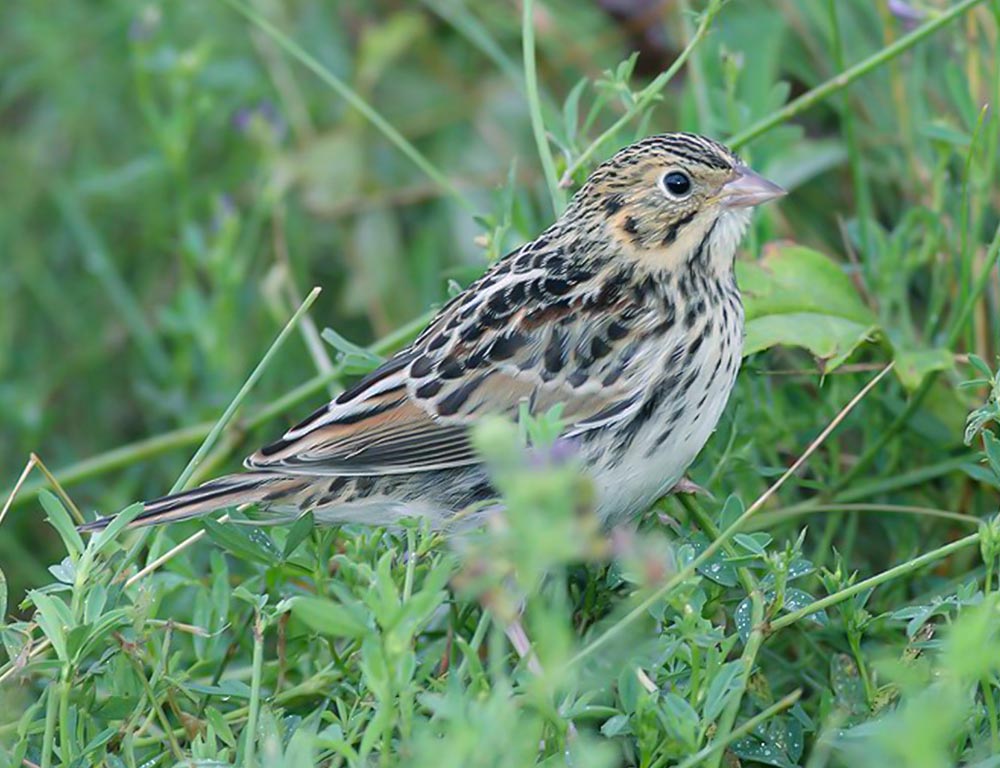
- Scientific Name: Centronyx bairdii
- Size: 5.5-6.3 inches
- Weight: 0.5-0.8 ounces
- Population: Localized and migratory
- Life Span: Up to 6 years
- Food: Seeds, insects
- Wingspan: 7.5-8.7 inches
Baird’s Sparrow is a grassland bird that breeds in open areas with tall grasses. They have a plain appearance with a buffy face and a streaked back.
This sparrow is known for its distinctive trilling song during the breeding season.
In Missouri, they may be encountered during migration. Their diet consists of seeds and insects, which are well-adapted to their grassland habitats.
Finding Baird’s Sparrows requires careful observation and an appreciation for the unique ecosystems they inhabit.
9. Henslow’s Sparrow
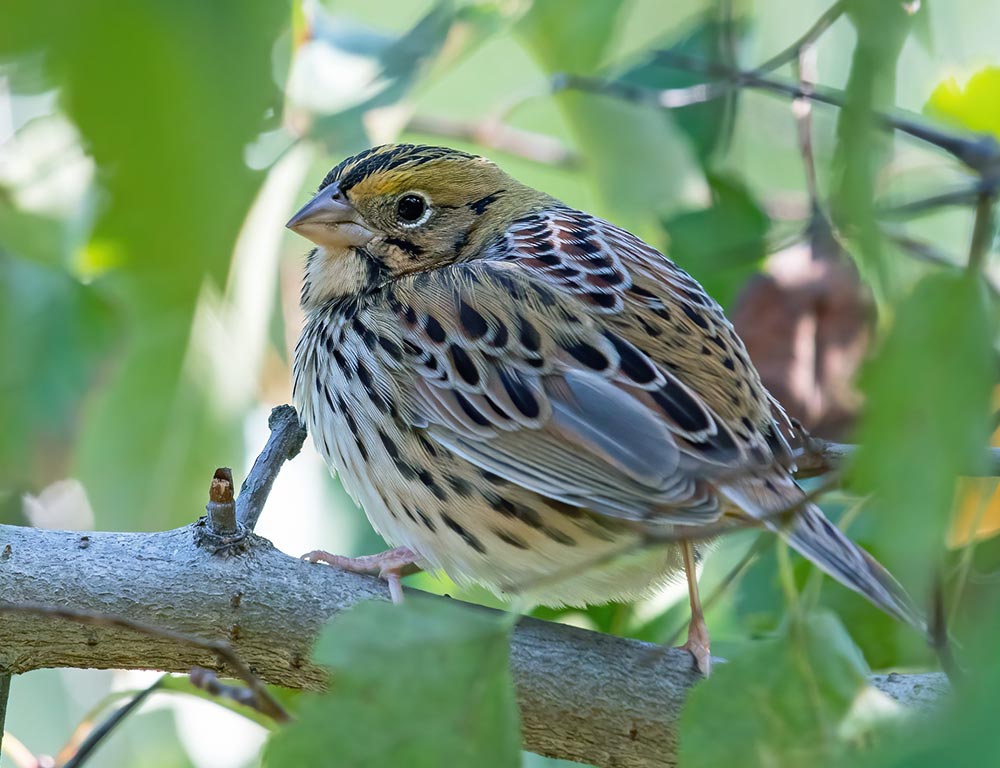
- Scientific Name: Centronyx henslowii
- Size: 4.7-5.9 inches
- Weight: 0.5-0.8 ounces
- Population: Declining and localized
- Life Span: Up to 5 years
- Food: Seeds, insects
- Wingspan: 7.5-8.7 inches
Henslow’s Sparrow is a grassland bird with a plain appearance, featuring a streaked back and a distinct flat-headed look.
Unfortunately, this species has experienced population declines, making sightings less common. They prefer tall grass habitats, often found in meadows and prairies.
Henslow’s Sparrows forage for seeds and insects close to the ground. Their soft, insect-like song is distinctive and helps identify them during the breeding season.
10. Savannah Sparrow
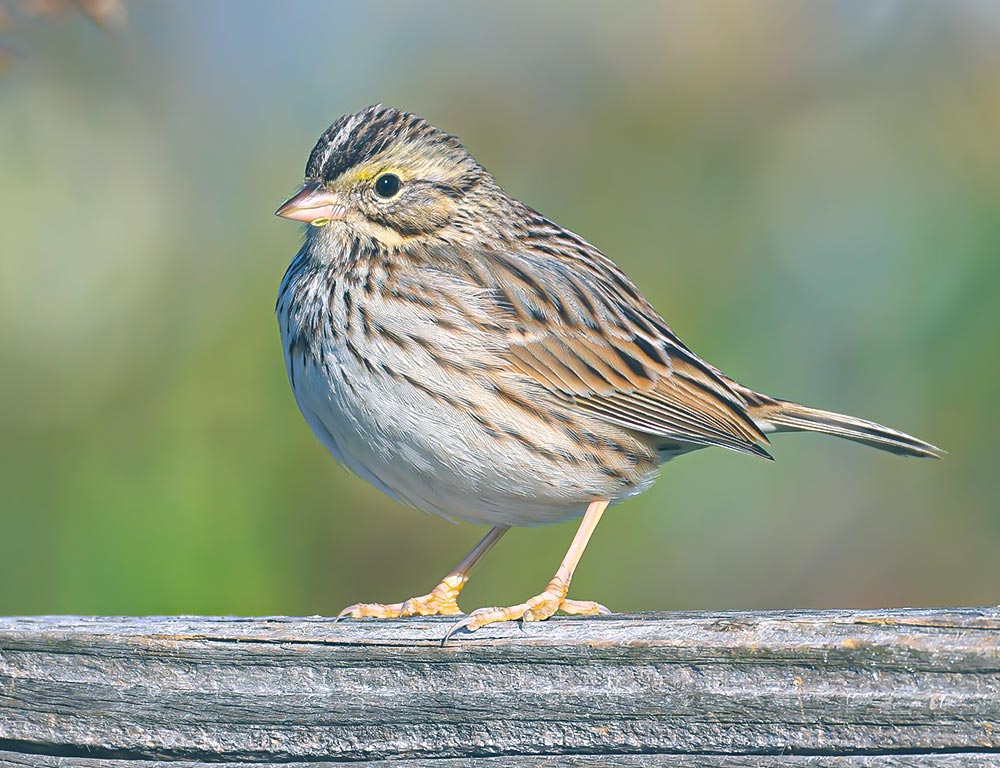
- Scientific Name: Passerculus sandwichensis
- Size: 4.7-6.7 inches
- Weight: 0.4-1.0 ounces
- Population: Common and widespread
- Life Span: Up to 6 years
- Food: Seeds, insects
- Wingspan: 7.1-9.1 inches
The Savannah Sparrow is a widespread species found in various habitats, including grasslands, marshes, and agricultural fields.
They have a streaked appearance with yellow above the eye.
Savannah Sparrows are known for their varied songs, including musical trills and buzzes. Their diet consists of seeds and insects, and they are often seen foraging on the ground or perched on low vegetation.
11. Song Sparrow
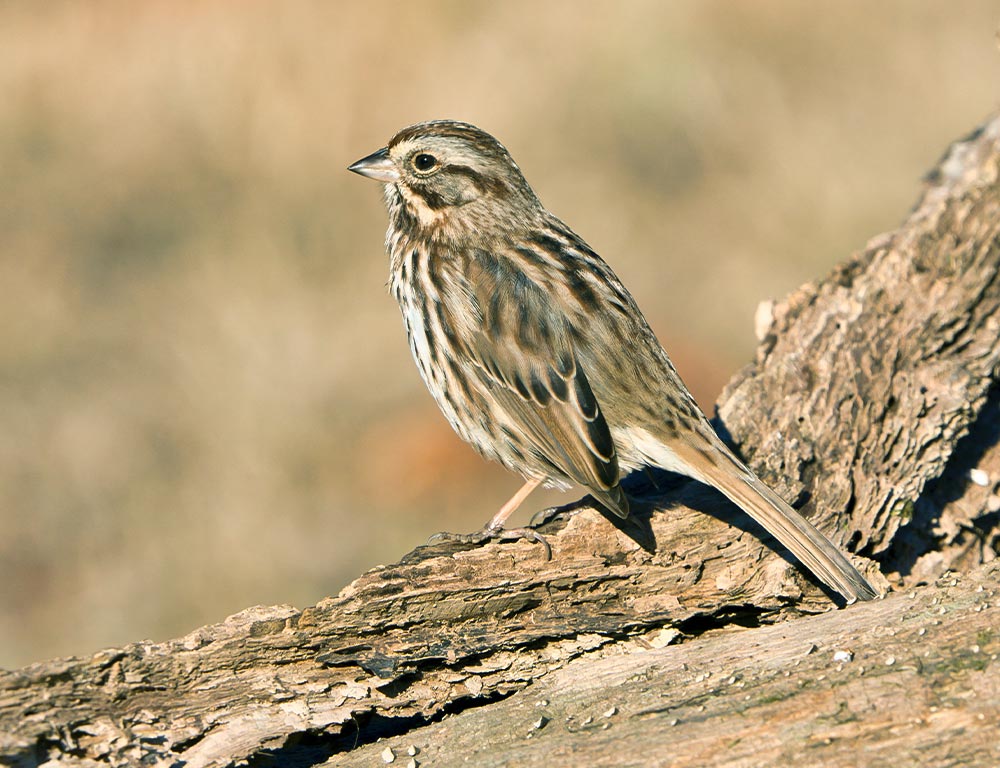
- Scientific Name: Melospiza melodia
- Size: 5.1-7.1 inches
- Weight: 0.4-1.3 ounces
- Population: Common and widespread
- Life Span: Up to 11 years
- Food: Seeds, insects, berries
- Wingspan: 7.9-9.8 inches
The Song Sparrow is a familiar and widespread bird found in various habitats, including gardens, woodlands, and marshes.
They have a streaked appearance with a central spot on their breast. Song Sparrows are known for their diverse and melodious songs.
Their diet includes seeds, insects, and berries. These adaptable sparrows are often seen foraging on the ground, and their varied vocalizations make them a joy to observe.
12. Lincoln’s Sparrow
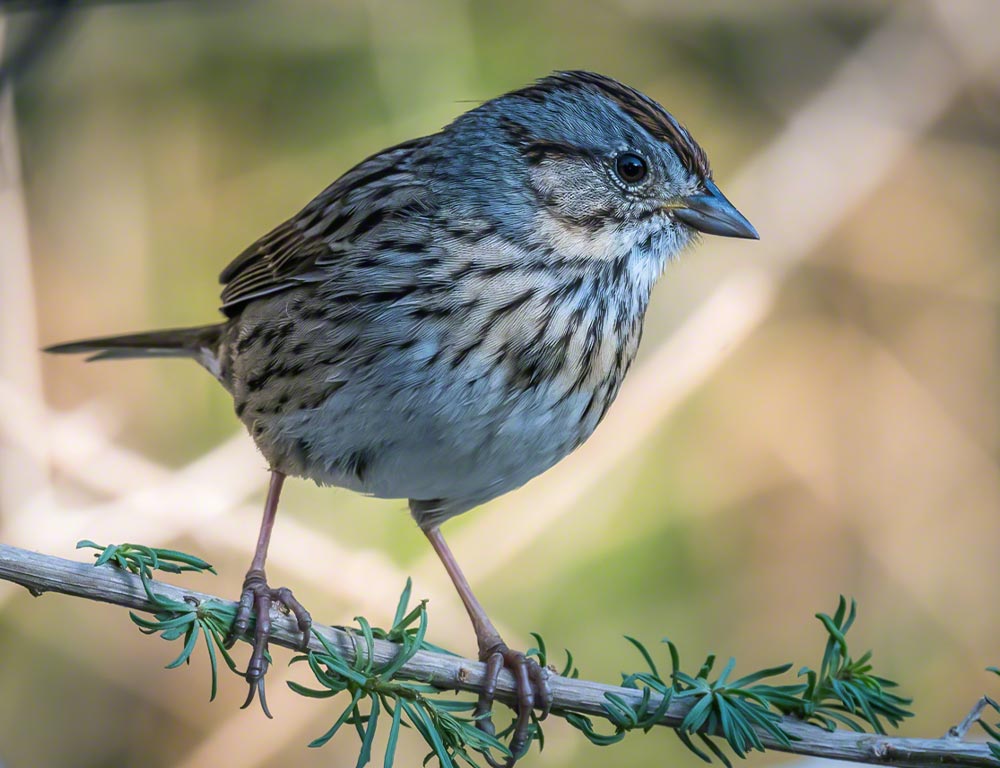
- Scientific Name: Melospiza lincolnii
- Size: 5.1-6.3 inches
- Weight: 0.5-0.8 ounces
- Population: Common in migration
- Life Span: Up to 6 years
- Food: Seeds, insects
- Wingspan: 7.5-8.7 inches
Lincoln’s Sparrow is a migrant that passes through Missouri during migration seasons.
They have buffy breasts with fine streaks and a distinct facial pattern. These sparrows prefer dense vegetation, such as shrubs and grassy areas.
Lincoln’s Sparrows forage for seeds and insects on the ground and are known for their subdued, musical trilling songs. Spotting them may require patience and a keen eye in their preferred habitats.
13. Swamp Sparrow
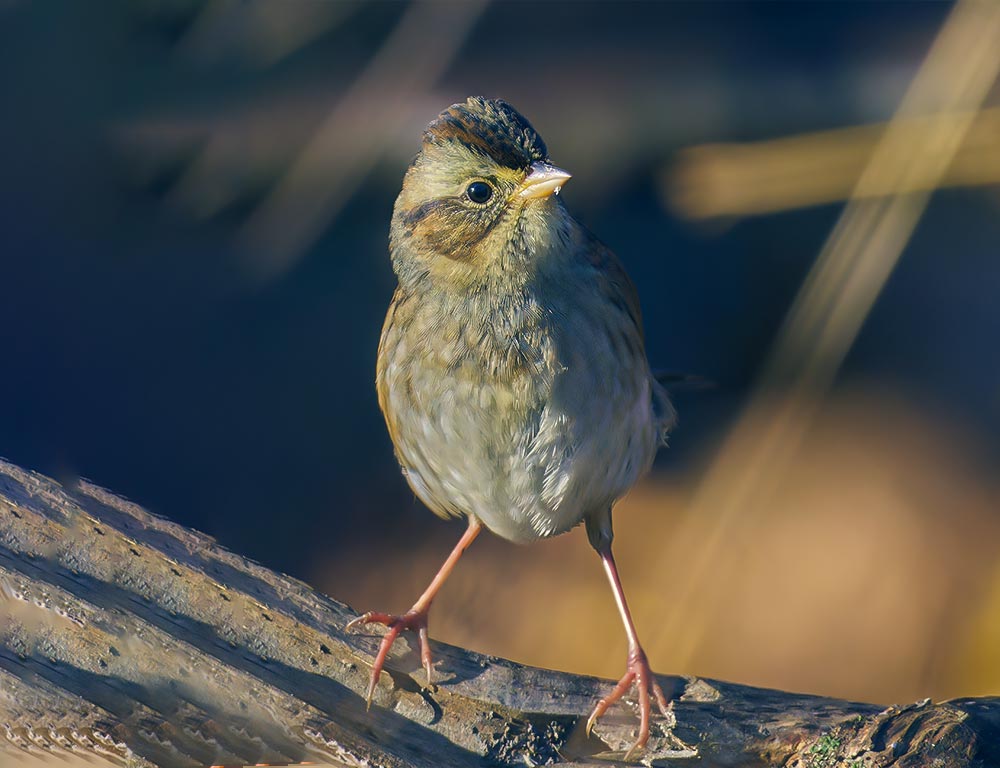
- Scientific Name: Melospiza georgiana
- Size: 4.7-6.7 inches
- Weight: 0.4-1.0 ounces
- Population: Common in wetland areas
- Life Span: Up to 9 years
- Food: Seeds, insects
- Wingspan: 7.9-9.1 inches
The Swamp Sparrow is associated with wetland habitats, including marshes, swamps, and stream edges. They have a rusty crown and a greyish face with a streaked appearance.
Swamp Sparrows forage for seeds and insects in the dense vegetation near water. Their distinctive chipping calls and trilling songs are characteristic of their wetland habitats.
These sparrows contribute to the biodiversity of wetland ecosystems and are often heard before they are seen.
14. Grasshopper Sparrow
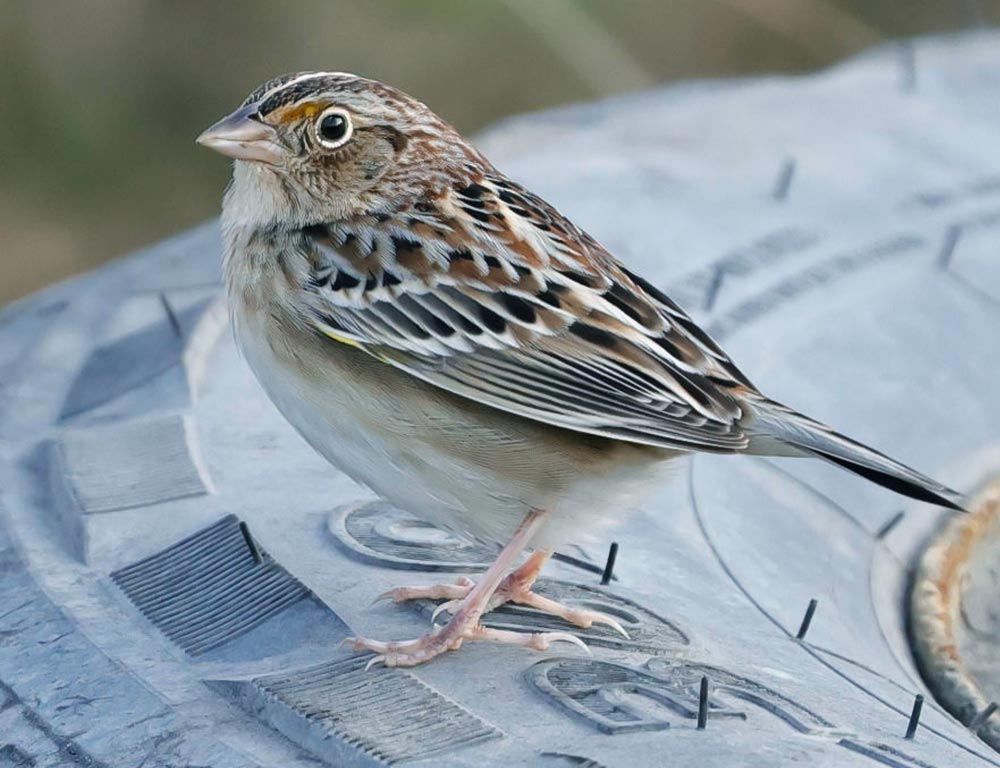
- Scientific Name: Ammodramus savannarum
- Size: 4.3-5.5 inches
- Weight: 0.3-0.6 ounces
- Population: Declining and localized
- Life Span: Up to 3 years
- Food: Seeds, insects
- Wingspan: 7.1-8.7 inches
The Grasshopper Sparrow is a small, ground-dwelling bird found in grasslands and prairies. It has a short tail and a streaked back.
Grasshopper Sparrows are known for their insect-like song, which often includes a series of high-pitched buzzes.
Unfortunately, their populations have been declining due to habitat loss. They forage for seeds and insects on the ground and are most active during the breeding season when their distinctive song can be heard.
15. Field Sparrow
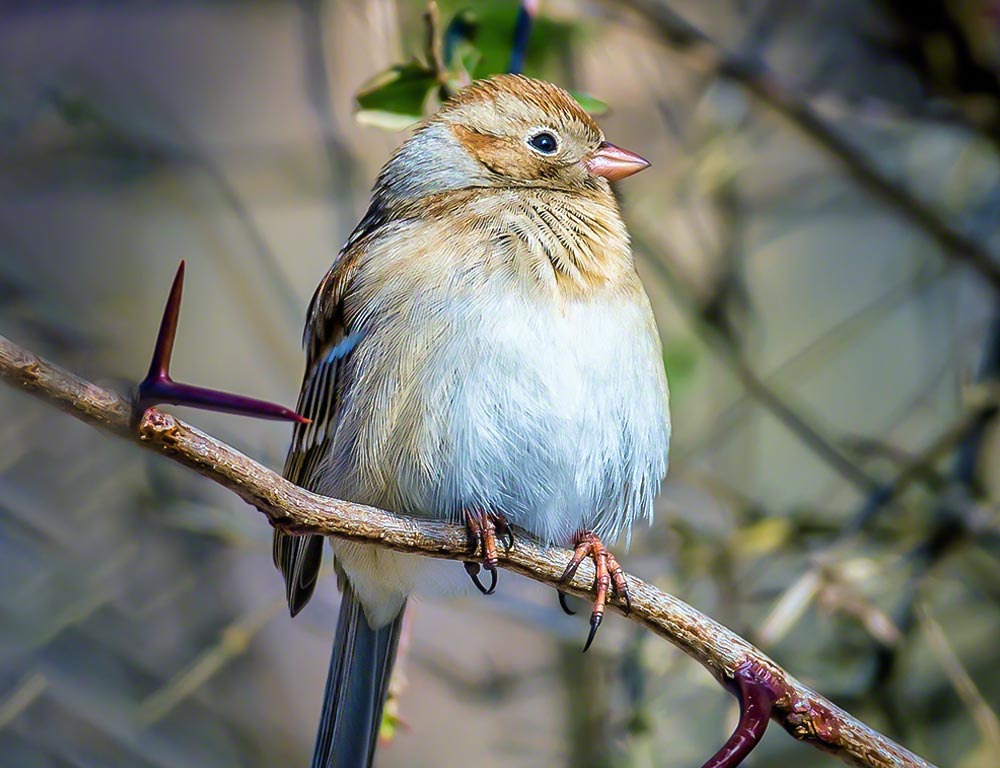
- Scientific Name: Spizella pusilla
- Size: 5.1-5.9 inches
- Weight: 0.4-0.6 ounces
- Population: Common and widespread
- Life Span: Up to 7 years
- Food: Seeds, insects
- Wingspan: 7.9-9.1 inches
The Field Sparrow is a small, chunky sparrow with a plain face and a pink bill.
It is commonly found in open habitats, including fields, meadows, and grassy areas. Field Sparrows have a sweet, musical song that they often sing from perches.
Their diet consists of seeds and insects, and they are known for their ground foraging behaviour. Field Sparrows are adaptable and can be seen in a variety of landscapes.
16. Fox Sparrow
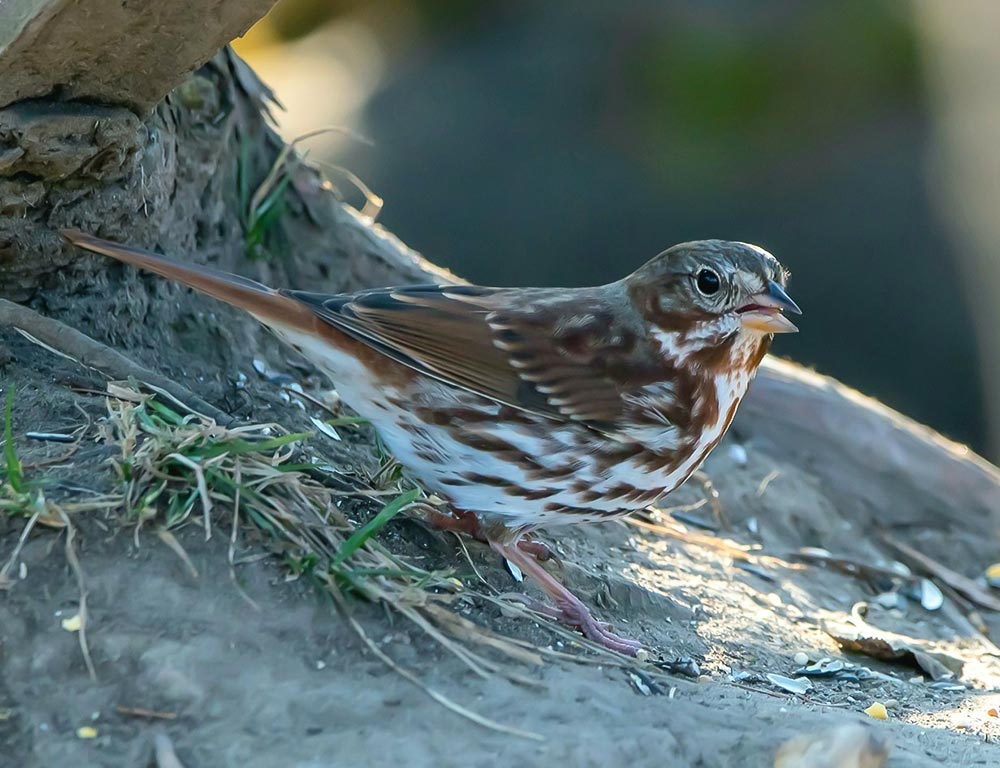
- Scientific Name: Passerella iliaca
- Size: 7.1-8.7 inches
- Weight: 1.1-1.6 ounces
- Population: Varied populations, migratory
- Life Span: Up to 6 years
- Food: Seeds, insects, berries
- Wingspan: 9.8-11.4 inches
The Fox Sparrow is a large, chunky sparrow with reddish-brown plumage and a heavily streaked breast.
It is a migratory bird in Missouri; it can be found during migration seasons. Fox Sparrows are often seen foraging on the ground in forested areas. Their diet includes seeds, insects, and berries.
They are known for their rich and melodious songs, which vary across their range. Fox Sparrows add diversity to the sparrow community with their distinctive appearance and vocalizations.
17. Lark Sparrow

- Scientific Name: Chondestes grammacus
- Size: 6.3-7.5 inches
- Weight: 0.9-1.2 ounces
- Population: Common and widespread
- Life Span: Up to 6 years
- Food: Seeds, insects
- Wingspan: 9.4-9.8 inches
The Lark Sparrow is a distinctive sparrow with bold facial markings, a chestnut crown, and white edges on its tail.
It is commonly found in grasslands, pastures, and open areas. Lark Sparrows forage for seeds and insects on the ground and may also capture insects in flight.
They are known for their complex songs, which often include both musical notes and buzzing sounds. Lark Sparrows are social birds and may be seen foraging in small flocks.
Their striking appearance and varied vocalizations make them a delight to observe in Missouri’s grassy landscapes.
18. Chipping Sparrow
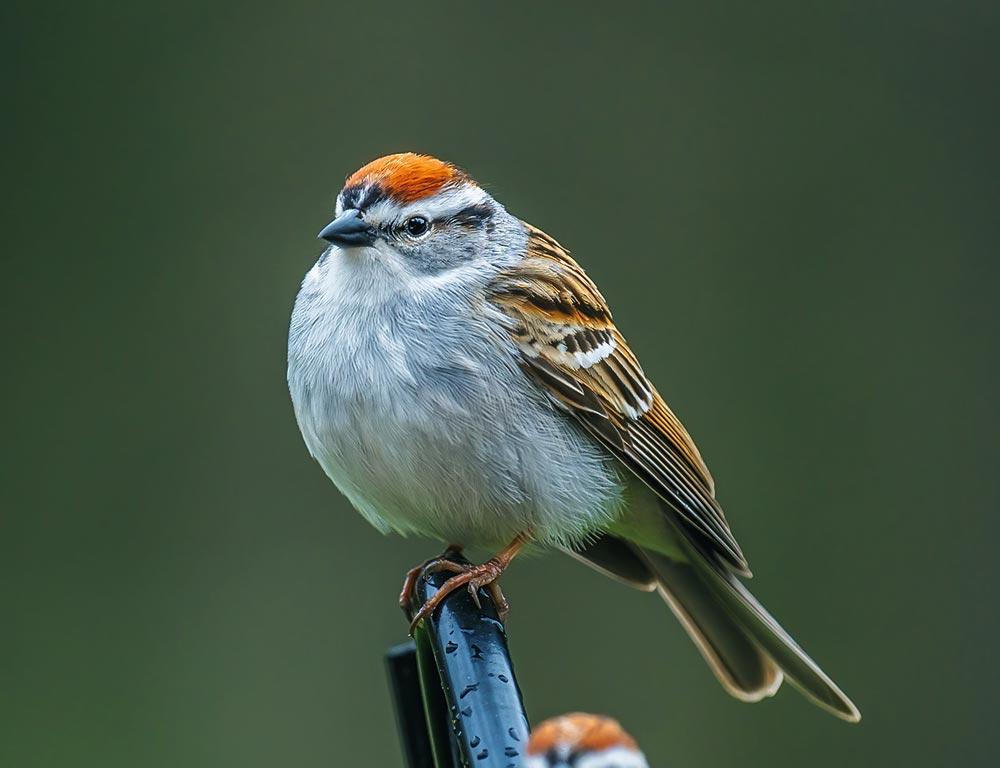
- Scientific Name: Spizella passerina
- Size: 4.7-5.9 inches
- Weight: 0.4-0.6 ounces
- Population: Common and widespread
- Life Span: Up to 8 years
- Food: Seeds, insects
- Wingspan: 7.1-9.1 inches
The Chipping Sparrow is a small and slender sparrow with a bright red cap on its head during the breeding season.
It is a common resident found in various habitats, including gardens, parks, and open woodlands. Chipping Sparrows are known for their distinct, sharp, chip-like calls.
They feed on seeds and insects, often foraging on the ground or in low vegetation. Their adaptability and pleasant appearance make them a familiar sight in residential areas.
19. Brewer’s Sparrow
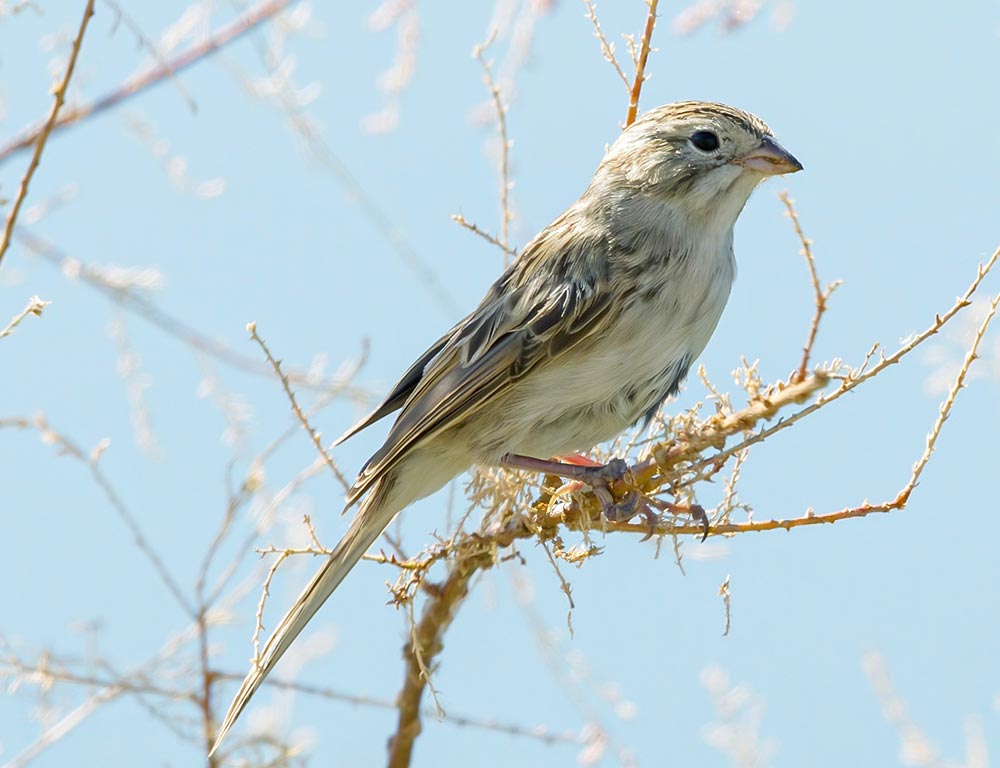
- Scientific Name: Spizella breweri
- Size: 4.7-5.9 inches
- Weight: 0.3-0.6 ounces
- Population: Common in western grasslands
- Life Span: Up to 5 years
- Food: Seeds, insects
- Wingspan: 7.5-8.7 inches
Brewer’s Sparrow is a small, greyish-brown sparrow with a plain appearance.
It is primarily found in open sagebrush habitats in the western United States. While less common in Missouri, it can be encountered during migration.
Brewer’s Sparrows forage for seeds and insects on the ground, and they are known for their buzzy songs. Spotting them may require careful observation due to their subtle plumage.
20. Clay-colored Sparrow
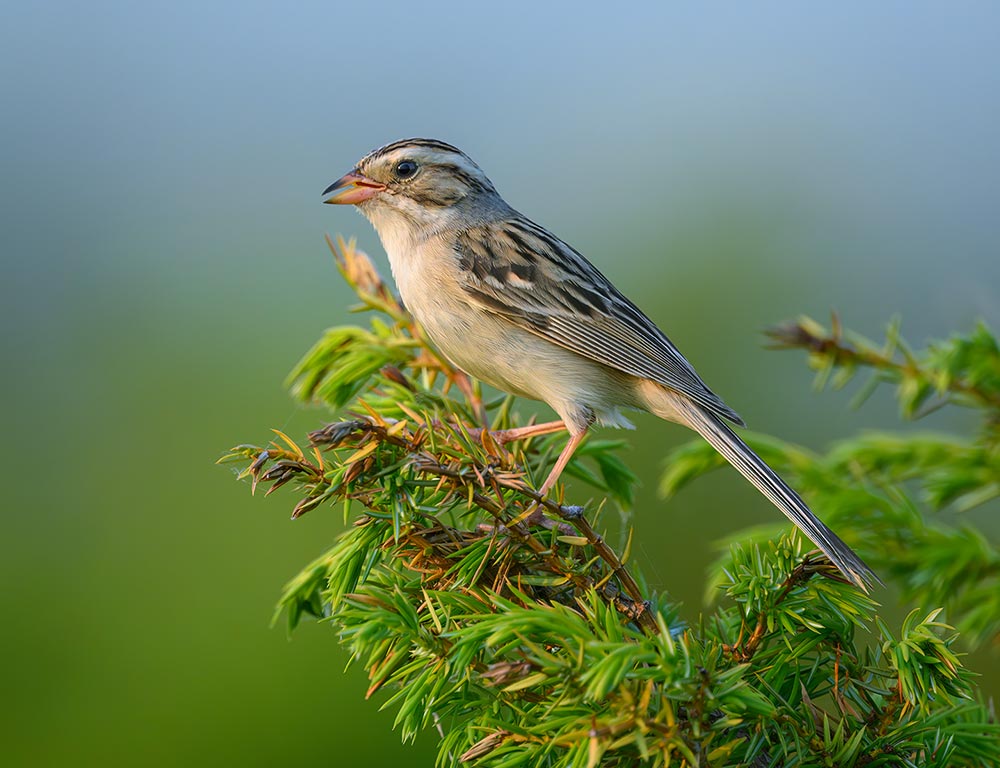
- Scientific Name: Spizella pallida
- Size: 4.7-5.9 inches
- Weight: 0.4-0.7 ounces
- Population: Localized and migratory
- Life Span: Up to 5 years
- Food: Seeds, insects
- Wingspan: 7.5-8.7 inches
The Clay-colored Sparrow is a small, pale sparrow with a distinct pale crown stripe.
It is often found in grasslands and shrubby areas, particularly during migration. Their song is a series of clear notes, and they forage for seeds and insects on the ground.
While not as common as some other sparrows, the Clay-colored Sparrow is an interesting species to encounter during Missouri’s spring and fall migration.
21. Lark Bunting
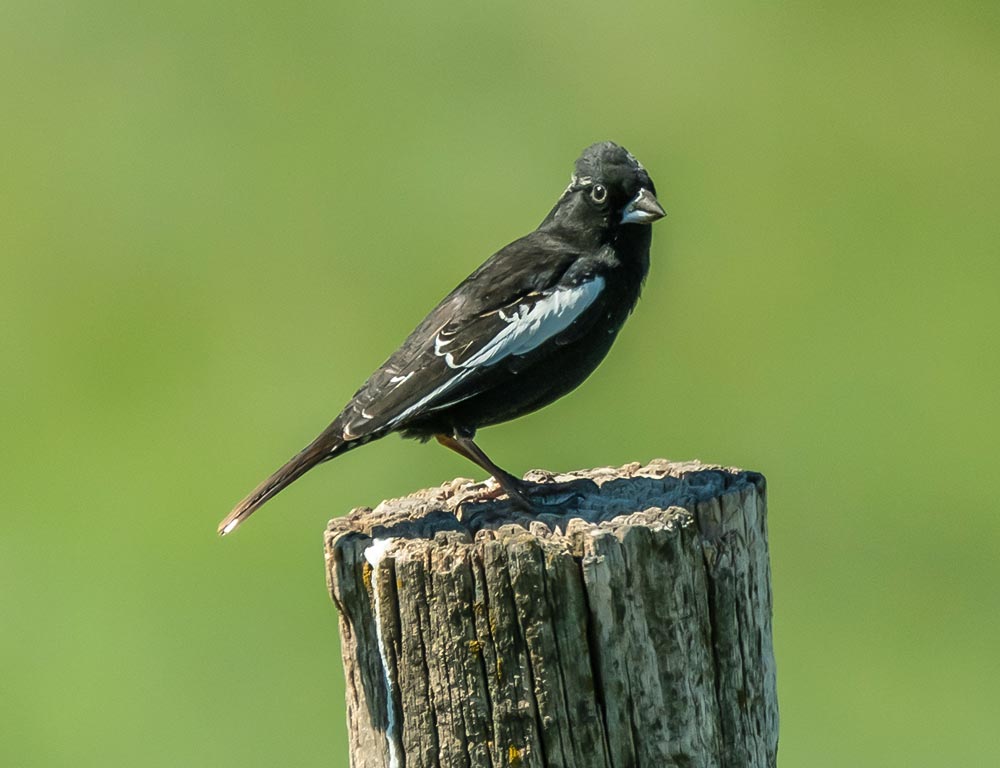
- Scientific Name: Calamospiza melanocorys
- Size: 6.3-7.5 inches
- Weight: 1.1-1.7 ounces
- Population: Varied populations, migratory
- Life Span: Up to 5 years
- Food: Seeds, insects
- Wingspan: 11.0-12.6 inches
The Lark Bunting is a distinctive sparrow with black-and-white plumage, particularly in males during the breeding season.
It breeds in the western United States and may be seen during migration in Missouri. Lark Buntings forage for seeds and insects in grasslands and open areas.
Their melodious songs and striking appearance make them notable during the breeding season, contributing to the diversity of sparrows in the region.
22. Dickcissel
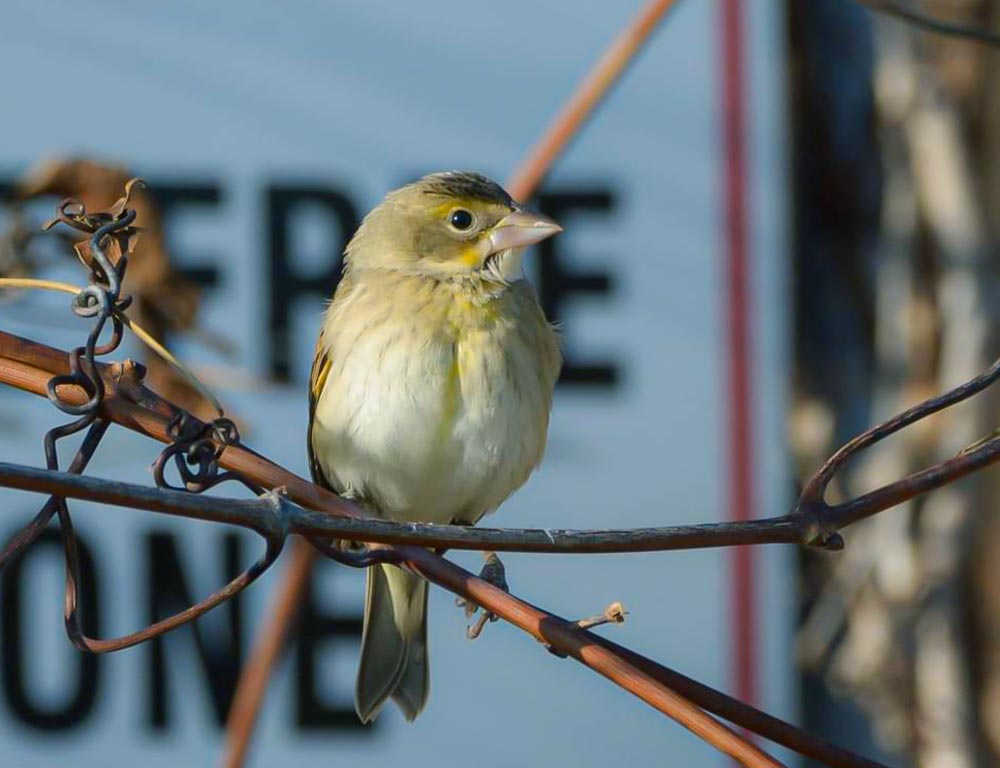
- Scientific Name: Spiza americana
- Size: 5.9-7.5 inches
- Weight: 1.2-1.6 ounces
- Population: Common in grasslands and agricultural areas
- Life Span: Up to 5 years
- Food: Seeds, insects
- Wingspan: 9.8-11.0 inches
While not a true sparrow, the Dickcissel is a distinctive member of the blackbird family often associated with sparrows due to its size and habitat preferences.
Dickcissels are commonly found in grasslands and agricultural areas, where they forage for seeds and insects.
Males are known for their buzzing, insect-like songs. Dickcissels are notable for their large numbers and their presence in open landscapes, adding to the avian diversity of Missouri’s grassy habitats.
In Missouri, these sparrows are vital in controlling insect populations and contributing to the region’s biodiversity.
They also add beauty to the landscape with their unique markings and melodious songs, enriching the birdwatching experience for enthusiasts.
Wrapping Up
In the mosaic of Missouri’s landscapes, sparrows play a vital role, contributing melodies and vibrant colours to our natural canvas.
These feathered residents, from the subtle Clay-colored Sparrow to the striking Lark Bunting, showcase the state’s biodiversity.
As we explore their habitats and behaviours, it becomes clear that each sparrow is a unique thread in the intricate tapestry of Missouri’s avian community.
Observing sparrows in Missouri offers not just a birdwatcher’s delight but also a glimpse into the ecological harmony of the region.
These sparrows, with their varied songs, behaviours, and distinctive features, remind us of the importance of preserving and appreciating the diverse ecosystems they call home. Thank you so much.